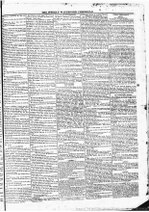 |
-

 Beautifully reproduced Woodford,Bourne & Co.Ltd Whiskey mirror. 50cm x 60cm Limerick Woodford Whiskies traded in Cork city for over 250 years. The warehouse was the hub of the companies bottling, storage and distribution operations supplying four shops in Cork and one in Limerick. The building was constructed between 1873 and 1875 at a cost of £4,500. When completed in 1875 the building was considered one of the finest in the city and today continues to be a listed building. The building with its cut limestone frontage has thick floor and roof beams made from imported Canadian white pine to support the weight of the full casks of wine and spirits stored in the warehouse. On the ground floor, you can still see the vaulted ceilings of the original cellars and throughout the building the thick stone walls built with master craftsmanship are on view everywhere. Over 10 years supply of whiskey, casks containing over a million bottles of wine, sherries and ports and more than 50,000 gallons of choice Cork and Dublin whiskies, Scotch whiskies and fine French brandies were all stored from seven to 10 years in wet and dry cellars.
Beautifully reproduced Woodford,Bourne & Co.Ltd Whiskey mirror. 50cm x 60cm Limerick Woodford Whiskies traded in Cork city for over 250 years. The warehouse was the hub of the companies bottling, storage and distribution operations supplying four shops in Cork and one in Limerick. The building was constructed between 1873 and 1875 at a cost of £4,500. When completed in 1875 the building was considered one of the finest in the city and today continues to be a listed building. The building with its cut limestone frontage has thick floor and roof beams made from imported Canadian white pine to support the weight of the full casks of wine and spirits stored in the warehouse. On the ground floor, you can still see the vaulted ceilings of the original cellars and throughout the building the thick stone walls built with master craftsmanship are on view everywhere. Over 10 years supply of whiskey, casks containing over a million bottles of wine, sherries and ports and more than 50,000 gallons of choice Cork and Dublin whiskies, Scotch whiskies and fine French brandies were all stored from seven to 10 years in wet and dry cellars.
Subsequent to a fire the building was restored and in 2001 received 1st Place in the Cork Corporation 'Better Building Award' for the restoration of a historic building. A book entitled 'The History of Woodford Bourne', written by David Nicholson a member of the family, was successfully launched in the warehouse in 2005. -
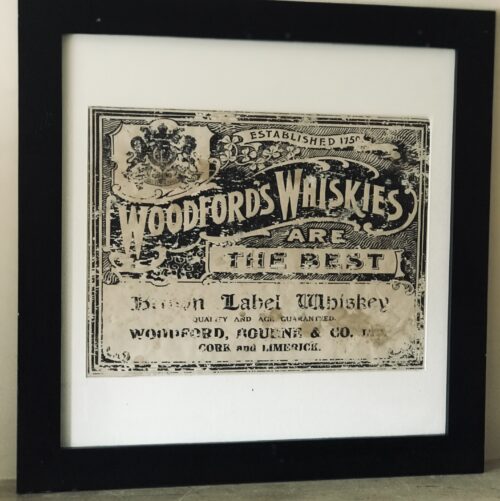
 Beautifully reproduced Woodford,Bourne & Co.Ltd Whiskey mirror. 50cm x 60cm Limerick Woodford Whiskies traded in Cork city for over 250 years. The warehouse was the hub of the companies bottling, storage and distribution operations supplying four shops in Cork and one in Limerick. The building was constructed between 1873 and 1875 at a cost of £4,500. When completed in 1875 the building was considered one of the finest in the city and today continues to be a listed building. The building with its cut limestone frontage has thick floor and roof beams made from imported Canadian white pine to support the weight of the full casks of wine and spirits stored in the warehouse. On the ground floor, you can still see the vaulted ceilings of the original cellars and throughout the building the thick stone walls built with master craftsmanship are on view everywhere. Over 10 years supply of whiskey, casks containing over a million bottles of wine, sherries and ports and more than 50,000 gallons of choice Cork and Dublin whiskies, Scotch whiskies and fine French brandies were all stored from seven to 10 years in wet and dry cellars.
Beautifully reproduced Woodford,Bourne & Co.Ltd Whiskey mirror. 50cm x 60cm Limerick Woodford Whiskies traded in Cork city for over 250 years. The warehouse was the hub of the companies bottling, storage and distribution operations supplying four shops in Cork and one in Limerick. The building was constructed between 1873 and 1875 at a cost of £4,500. When completed in 1875 the building was considered one of the finest in the city and today continues to be a listed building. The building with its cut limestone frontage has thick floor and roof beams made from imported Canadian white pine to support the weight of the full casks of wine and spirits stored in the warehouse. On the ground floor, you can still see the vaulted ceilings of the original cellars and throughout the building the thick stone walls built with master craftsmanship are on view everywhere. Over 10 years supply of whiskey, casks containing over a million bottles of wine, sherries and ports and more than 50,000 gallons of choice Cork and Dublin whiskies, Scotch whiskies and fine French brandies were all stored from seven to 10 years in wet and dry cellars.
Subsequent to a fire the building was restored and in 2001 received 1st Place in the Cork Corporation 'Better Building Award' for the restoration of a historic building. A book entitled 'The History of Woodford Bourne', written by David Nicholson a member of the family, was successfully launched in the warehouse in 2005.
-
Out of stock
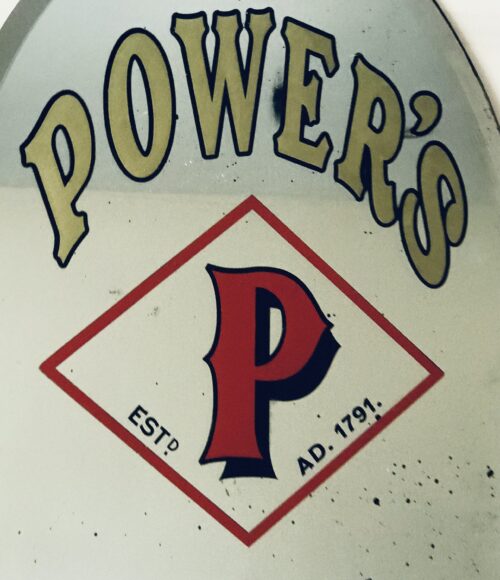
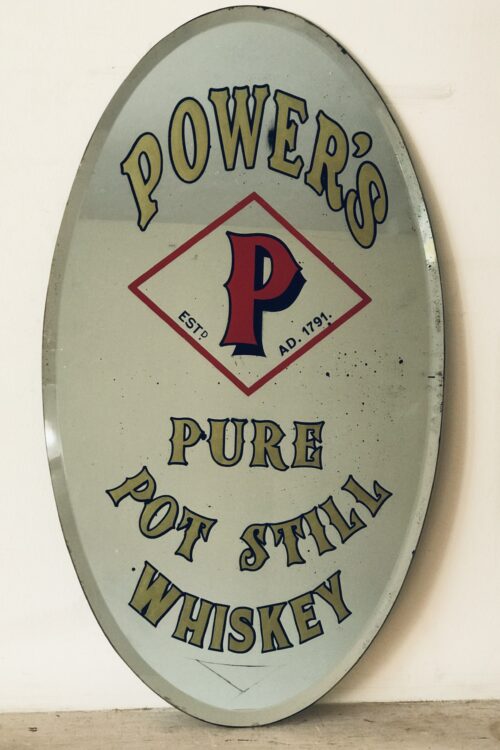 Stunning 1940's Power's Pure Pot Still Whiskey Mirror 65cm x 37cm Dublin In 1791 James Power, an innkeeper from Dublin, established a small distillery at his public house at 109 Thomas St., Dublin. The distillery, which had an output of about 6,000 gallons in its first year of operation, initially traded as James Power and Son, but by 1822 had become John Power & Son, and had moved to a new premises at John's Lane, a side street off Thomas Street. At the time the distillery had three pot stills, though only one, a 500-gallon still is thought to have been in use. Following reform of the distilling laws in 1823, the distillery expanded rapidly. In 1827, production was reported at 160,270 gallons,and by 1833 had grown to 300,000 gallons per annum. As the distillery grew, so too did the stature of the family. In 1841, John Power, grandson of the founder was awarded a baronet, a hereditary title. In 1855, his son Sir James Power, laid the foundation stone for the O'Connell Monument, and in 1859 became High Sheriff of Dublin. In 1871, the distillery was expanded and rebuilt in the Victorian style, becoming one of the most impressive sights in Dublin.After expansion, output at the distillery rose to 700,000 gallons per annum, and by the 1880s, had reached about 900,000 gallons per annum, at which point the distillery covered over six acres of central Dublin, and had a staff of about 300 people.During this period, when the Dublin whiskey distilleries were amongst the largest in the world, the family run firms of John Powers, along with John Jameson, William Jameson, and George Roe, (collectively known as the "Big Four") came to dominate the Irish distilling landscape, introducing several innovations. In 1886, John Power & Son began bottling their own whiskey, rather than following the practice customary at the time, of selling whiskey directly to merchants and bonders who would bottle it themselves. They were the first Dublin distillery to do so, and one of the first in the world.A gold label adorned each bottle and it was from these that the whiskey got the name Powers Gold Label. When Alfred Barnard, the British historian visited John's Lane in the late 1880s, he noted the elegance and cleanliness of the buildings, and the modernity of the distillery, describing it as "about as complete a work as it is possible to find anywhere". At the time of his visit, the distillery was home to five pot stills, two of which with capacities of 25,000 gallons, were amongst the largest ever built.In addition, Barnard was high in his praise for Powers whiskey, noting:"The old make, which we drank with our luncheon was delicious and finer than anything we had hitherto tasted.It was as perfect in flavour, and as pronounced in the ancient aroma of Irish Whiskey so dear to to the hearts of connoisseurs,as one could possibly desire and we found a small flask of it very useful afterwards on our travels." The last member of the family to sit on the board was Sir Thomas Talbot Power,who died in 1930,and with him the Power's Baronetcy. However, ownership remained in the family until 1966, and several descendants of his sisters remained at work with the company until recent times. In 1961, a Coffey still was installed in John's Lane Distillery, allowing the production of vodka and gin, in addition to the testing of grain whiskey for use in blended whiskey. This was a notable departure for the firm, as for many years the big Dublin distilling dynasties had shunned the use of Coffey stills, questioning if their output, grain whiskey could even be termed whiskey. However, with many of the Irish distilleries having closed in the early 20th century in part due to their failure to embrace a change in consumer preference towards blended whiskey, Powers were instrumental in convincing the remaining Irish distilleries to reconsider their stance on blended whiskey. In 1966, with the Irish whiskey industry still struggling following Prohibition in the United States, the Anglo-Irish Trade War and the rise of competition from Scotch whiskey, John Powers & Son joined forces with the only other remaining distillers in the Irish Republic, the Cork Distilleries Company and their Dublin rivals John Jameson & Son, to form Irish Distillers. Soon after, in a bold move, Irish Distillers decided to close all of their existing distilleries, and to consolidate production at a new purpose-built facility in Midleton (the New Midleton Distillery) alongside their existing Old Midleton Distillery. The new distillery opened in 1975, and a year later, production ceased at John's Lane Distillery and began anew in Cork, with Powers Gold Label and many other Irish whiskeys reformulated from single pot stills whiskeys to blends. In 1989, Irish Distillers itself became a subsidiary of Pernod-Ricard following a friendly takeover.Since the closure of the John's Lane distillery, many of the distillery buildings were demolished. However, some of the buildings have been incorporated into the National College of Art and Design, and are now protected structures. In addition, three of the distillery's pot stills were saved and now located in the college's Red Square. Origins : Dublin City Dimensions : 100cm x 70cm 20kg (specially constructed damage proof shipping container)
Stunning 1940's Power's Pure Pot Still Whiskey Mirror 65cm x 37cm Dublin In 1791 James Power, an innkeeper from Dublin, established a small distillery at his public house at 109 Thomas St., Dublin. The distillery, which had an output of about 6,000 gallons in its first year of operation, initially traded as James Power and Son, but by 1822 had become John Power & Son, and had moved to a new premises at John's Lane, a side street off Thomas Street. At the time the distillery had three pot stills, though only one, a 500-gallon still is thought to have been in use. Following reform of the distilling laws in 1823, the distillery expanded rapidly. In 1827, production was reported at 160,270 gallons,and by 1833 had grown to 300,000 gallons per annum. As the distillery grew, so too did the stature of the family. In 1841, John Power, grandson of the founder was awarded a baronet, a hereditary title. In 1855, his son Sir James Power, laid the foundation stone for the O'Connell Monument, and in 1859 became High Sheriff of Dublin. In 1871, the distillery was expanded and rebuilt in the Victorian style, becoming one of the most impressive sights in Dublin.After expansion, output at the distillery rose to 700,000 gallons per annum, and by the 1880s, had reached about 900,000 gallons per annum, at which point the distillery covered over six acres of central Dublin, and had a staff of about 300 people.During this period, when the Dublin whiskey distilleries were amongst the largest in the world, the family run firms of John Powers, along with John Jameson, William Jameson, and George Roe, (collectively known as the "Big Four") came to dominate the Irish distilling landscape, introducing several innovations. In 1886, John Power & Son began bottling their own whiskey, rather than following the practice customary at the time, of selling whiskey directly to merchants and bonders who would bottle it themselves. They were the first Dublin distillery to do so, and one of the first in the world.A gold label adorned each bottle and it was from these that the whiskey got the name Powers Gold Label. When Alfred Barnard, the British historian visited John's Lane in the late 1880s, he noted the elegance and cleanliness of the buildings, and the modernity of the distillery, describing it as "about as complete a work as it is possible to find anywhere". At the time of his visit, the distillery was home to five pot stills, two of which with capacities of 25,000 gallons, were amongst the largest ever built.In addition, Barnard was high in his praise for Powers whiskey, noting:"The old make, which we drank with our luncheon was delicious and finer than anything we had hitherto tasted.It was as perfect in flavour, and as pronounced in the ancient aroma of Irish Whiskey so dear to to the hearts of connoisseurs,as one could possibly desire and we found a small flask of it very useful afterwards on our travels." The last member of the family to sit on the board was Sir Thomas Talbot Power,who died in 1930,and with him the Power's Baronetcy. However, ownership remained in the family until 1966, and several descendants of his sisters remained at work with the company until recent times. In 1961, a Coffey still was installed in John's Lane Distillery, allowing the production of vodka and gin, in addition to the testing of grain whiskey for use in blended whiskey. This was a notable departure for the firm, as for many years the big Dublin distilling dynasties had shunned the use of Coffey stills, questioning if their output, grain whiskey could even be termed whiskey. However, with many of the Irish distilleries having closed in the early 20th century in part due to their failure to embrace a change in consumer preference towards blended whiskey, Powers were instrumental in convincing the remaining Irish distilleries to reconsider their stance on blended whiskey. In 1966, with the Irish whiskey industry still struggling following Prohibition in the United States, the Anglo-Irish Trade War and the rise of competition from Scotch whiskey, John Powers & Son joined forces with the only other remaining distillers in the Irish Republic, the Cork Distilleries Company and their Dublin rivals John Jameson & Son, to form Irish Distillers. Soon after, in a bold move, Irish Distillers decided to close all of their existing distilleries, and to consolidate production at a new purpose-built facility in Midleton (the New Midleton Distillery) alongside their existing Old Midleton Distillery. The new distillery opened in 1975, and a year later, production ceased at John's Lane Distillery and began anew in Cork, with Powers Gold Label and many other Irish whiskeys reformulated from single pot stills whiskeys to blends. In 1989, Irish Distillers itself became a subsidiary of Pernod-Ricard following a friendly takeover.Since the closure of the John's Lane distillery, many of the distillery buildings were demolished. However, some of the buildings have been incorporated into the National College of Art and Design, and are now protected structures. In addition, three of the distillery's pot stills were saved and now located in the college's Red Square. Origins : Dublin City Dimensions : 100cm x 70cm 20kg (specially constructed damage proof shipping container) The Still House at John's Lane Distillery, as it looked when Alfred Barnard visited in the 1800s.
The Still House at John's Lane Distillery, as it looked when Alfred Barnard visited in the 1800s.
-
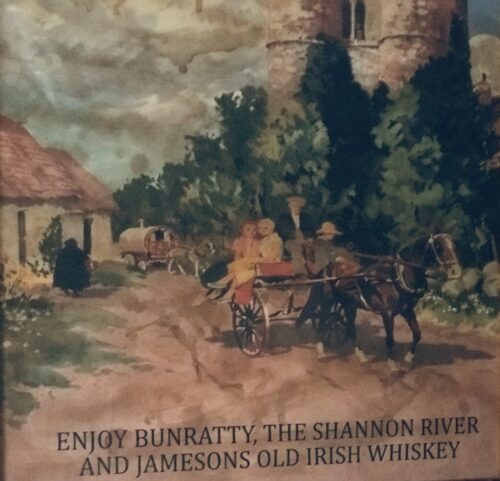
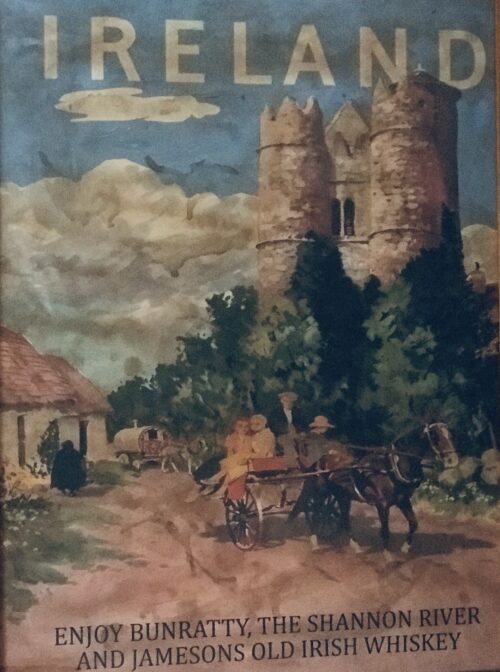 Very rare example of a Jameson led advertising campaign extolling the delights of Ireland,in particular Bunratty Castle,the Shannon River as well as Jamesons old Irish Whiskey obviously! This delightful print demonstrates the unique old world charm of Ireland in the 1950s. 420cm x 60cm (unframed -limited edition poster form) John Jameson was originally a lawyer from Alloa in Scotland before he founded his eponymous distillery in Dublin in 1780.Prevoius to this he had made the wise move of marrying Margaret Haig (1753–1815) in 1768,one of the simple reasons being Margaret was the eldest daughter of John Haig, the famous whisky distiller in Scotland. John and Margaret had eight sons and eight daughters, a family of 16 children. Portraits of the couple by Sir Henry Raeburn are on display in the National Gallery of Ireland. John Jameson joined the Convivial Lodge No. 202, of the Dublin Freemasons on the 24th June 1774 and in 1780, Irish whiskey distillation began at Bow Street. In 1805, he was joined by his son John Jameson II who took over the family business that year and for the next 41 years, John Jameson II built up the business before handing over to his son John Jameson the 3rd in 1851. In 1901, the Company was formally incorporated as John Jameson and Son Ltd. Four of John Jameson’s sons followed his footsteps in distilling in Ireland, John Jameson II (1773 – 1851) at Bow Street, William and James Jameson at Marrowbone Lane in Dublin (where they partnered their Stein relations, calling their business Jameson and Stein, before settling on William Jameson & Co.). The fourth of Jameson's sons, Andrew, who had a small distillery at Enniscorthy, Co. Wexford, was the grandfather of Guglielmo Marconi, inventor of wireless telegraphy. Marconi’s mother was Annie Jameson, Andrew’s daughter. John Jameson’s eldest son, Robert took over his father’s legal business in Alloa. The Jamesons became the most important distilling family in Ireland, despite rivalry between the Bow Street and Marrowbone Lane distilleries. By the turn of the 19th century, it was the second largest producer in Ireland and one of the largest in the world, producing 1,000,000 gallons annually. Dublin at the time was the centre of world whiskey production. It was the second most popular spirit in the world after rum and internationally Jameson had by 1805 become the world's number one whiskey. Today, Jameson is the world's third largest single-distillery whiskey. Historical events, for a time, set the company back. The temperance movement in Ireland had an enormous impact domestically but the two key events that affected Jameson were the Irish War of Independence and subsequent trade war with the British which denied Jameson the export markets of the Commonwealth, and shortly thereafter, the introduction of prohibition in the United States. While Scottish brands could easily slip across the Canada–US border, Jameson was excluded from its biggest market for many years. The introduction of column stills by the Scottish blenders in the mid-19th-century enabled increased production that the Irish, still making labour-intensive single pot still whiskey, could not compete with. There was a legal enquiry somewhere in 1908 to deal with the trade definition of whiskey. The Scottish producers won within some jurisdictions, and blends became recognised in the law of that jurisdiction as whiskey. The Irish in general, and Jameson in particular, continued with the traditional pot still production process for many years.In 1966 John Jameson merged with Cork Distillers and John Powers to form the Irish Distillers Group. In 1976, the Dublin whiskey distilleries of Jameson in Bow Street and in John's Lane were closed following the opening of a New Midleton Distillery by Irish Distillers outside Cork. The Midleton Distillery now produces much of the Irish whiskey sold in Ireland under the Jameson, Midleton, Powers, Redbreast, Spot and Paddy labels. The new facility adjoins the Old Midleton Distillery, the original home of the Paddy label, which is now home to the Jameson Experience Visitor Centre and the Irish Whiskey Academy. The Jameson brand was acquired by the French drinks conglomerate Pernod Ricard in 1988, when it bought Irish Distillers. The old Jameson Distillery in Bow Street near Smithfield in Dublin now serves as a museum which offers tours and tastings. The distillery, which is historical in nature and no longer produces whiskey on site, went through a $12.6 million renovation that was concluded in March 2016, and is now a focal part of Ireland's strategy to raise the number of whiskey tourists, which stood at 600,000 in 2017.Bow Street also now has a fully functioning Maturation Warehouse within its walls since the 2016 renovation. It is here that Jameson 18 Bow Street is finished before being bottled at Cask Strength. In 2008, The Local, an Irish pub in Minneapolis, sold 671 cases of Jameson (22 bottles a day),making it the largest server of Jameson's in the world – a title it maintained for four consecutive years.
Very rare example of a Jameson led advertising campaign extolling the delights of Ireland,in particular Bunratty Castle,the Shannon River as well as Jamesons old Irish Whiskey obviously! This delightful print demonstrates the unique old world charm of Ireland in the 1950s. 420cm x 60cm (unframed -limited edition poster form) John Jameson was originally a lawyer from Alloa in Scotland before he founded his eponymous distillery in Dublin in 1780.Prevoius to this he had made the wise move of marrying Margaret Haig (1753–1815) in 1768,one of the simple reasons being Margaret was the eldest daughter of John Haig, the famous whisky distiller in Scotland. John and Margaret had eight sons and eight daughters, a family of 16 children. Portraits of the couple by Sir Henry Raeburn are on display in the National Gallery of Ireland. John Jameson joined the Convivial Lodge No. 202, of the Dublin Freemasons on the 24th June 1774 and in 1780, Irish whiskey distillation began at Bow Street. In 1805, he was joined by his son John Jameson II who took over the family business that year and for the next 41 years, John Jameson II built up the business before handing over to his son John Jameson the 3rd in 1851. In 1901, the Company was formally incorporated as John Jameson and Son Ltd. Four of John Jameson’s sons followed his footsteps in distilling in Ireland, John Jameson II (1773 – 1851) at Bow Street, William and James Jameson at Marrowbone Lane in Dublin (where they partnered their Stein relations, calling their business Jameson and Stein, before settling on William Jameson & Co.). The fourth of Jameson's sons, Andrew, who had a small distillery at Enniscorthy, Co. Wexford, was the grandfather of Guglielmo Marconi, inventor of wireless telegraphy. Marconi’s mother was Annie Jameson, Andrew’s daughter. John Jameson’s eldest son, Robert took over his father’s legal business in Alloa. The Jamesons became the most important distilling family in Ireland, despite rivalry between the Bow Street and Marrowbone Lane distilleries. By the turn of the 19th century, it was the second largest producer in Ireland and one of the largest in the world, producing 1,000,000 gallons annually. Dublin at the time was the centre of world whiskey production. It was the second most popular spirit in the world after rum and internationally Jameson had by 1805 become the world's number one whiskey. Today, Jameson is the world's third largest single-distillery whiskey. Historical events, for a time, set the company back. The temperance movement in Ireland had an enormous impact domestically but the two key events that affected Jameson were the Irish War of Independence and subsequent trade war with the British which denied Jameson the export markets of the Commonwealth, and shortly thereafter, the introduction of prohibition in the United States. While Scottish brands could easily slip across the Canada–US border, Jameson was excluded from its biggest market for many years. The introduction of column stills by the Scottish blenders in the mid-19th-century enabled increased production that the Irish, still making labour-intensive single pot still whiskey, could not compete with. There was a legal enquiry somewhere in 1908 to deal with the trade definition of whiskey. The Scottish producers won within some jurisdictions, and blends became recognised in the law of that jurisdiction as whiskey. The Irish in general, and Jameson in particular, continued with the traditional pot still production process for many years.In 1966 John Jameson merged with Cork Distillers and John Powers to form the Irish Distillers Group. In 1976, the Dublin whiskey distilleries of Jameson in Bow Street and in John's Lane were closed following the opening of a New Midleton Distillery by Irish Distillers outside Cork. The Midleton Distillery now produces much of the Irish whiskey sold in Ireland under the Jameson, Midleton, Powers, Redbreast, Spot and Paddy labels. The new facility adjoins the Old Midleton Distillery, the original home of the Paddy label, which is now home to the Jameson Experience Visitor Centre and the Irish Whiskey Academy. The Jameson brand was acquired by the French drinks conglomerate Pernod Ricard in 1988, when it bought Irish Distillers. The old Jameson Distillery in Bow Street near Smithfield in Dublin now serves as a museum which offers tours and tastings. The distillery, which is historical in nature and no longer produces whiskey on site, went through a $12.6 million renovation that was concluded in March 2016, and is now a focal part of Ireland's strategy to raise the number of whiskey tourists, which stood at 600,000 in 2017.Bow Street also now has a fully functioning Maturation Warehouse within its walls since the 2016 renovation. It is here that Jameson 18 Bow Street is finished before being bottled at Cask Strength. In 2008, The Local, an Irish pub in Minneapolis, sold 671 cases of Jameson (22 bottles a day),making it the largest server of Jameson's in the world – a title it maintained for four consecutive years. -

 Fantastic John Jameson advertising print from the 1950s.Will provide a stunning feature above a doorway in any Irish pub or home bar with an affinity for all things Jameson. Tullamore Co Offaly 61cm x 86cm John Jameson was originally a lawyer from Alloa in Scotland before he founded his eponymous distillery in Dublin in 1780.Prevoius to this he had made the wise move of marrying Margaret Haig (1753–1815) in 1768,one of the simple reasons being Margaret was the eldest daughter of John Haig, the famous whisky distiller in Scotland. John and Margaret had eight sons and eight daughters, a family of 16 children. Portraits of the couple by Sir Henry Raeburn are on display in the National Gallery of Ireland. John Jameson joined the Convivial Lodge No. 202, of the Dublin Freemasons on the 24th June 1774 and in 1780, Irish whiskey distillation began at Bow Street. In 1805, he was joined by his son John Jameson II who took over the family business that year and for the next 41 years, John Jameson II built up the business before handing over to his son John Jameson the 3rd in 1851. In 1901, the Company was formally incorporated as John Jameson and Son Ltd. Four of John Jameson’s sons followed his footsteps in distilling in Ireland, John Jameson II (1773 – 1851) at Bow Street, William and James Jameson at Marrowbone Lane in Dublin (where they partnered their Stein relations, calling their business Jameson and Stein, before settling on William Jameson & Co.). The fourth of Jameson's sons, Andrew, who had a small distillery at Enniscorthy, Co. Wexford, was the grandfather of Guglielmo Marconi, inventor of wireless telegraphy. Marconi’s mother was Annie Jameson, Andrew’s daughter. John Jameson’s eldest son, Robert took over his father’s legal business in Alloa. The Jamesons became the most important distilling family in Ireland, despite rivalry between the Bow Street and Marrowbone Lane distilleries. By the turn of the 19th century, it was the second largest producer in Ireland and one of the largest in the world, producing 1,000,000 gallons annually. Dublin at the time was the centre of world whiskey production. It was the second most popular spirit in the world after rum and internationally Jameson had by 1805 become the world's number one whiskey. Today, Jameson is the world's third largest single-distillery whiskey. Historical events, for a time, set the company back. The temperance movement in Ireland had an enormous impact domestically but the two key events that affected Jameson were the Irish War of Independence and subsequent trade war with the British which denied Jameson the export markets of the Commonwealth, and shortly thereafter, the introduction of prohibition in the United States. While Scottish brands could easily slip across the Canada–US border, Jameson was excluded from its biggest market for many years. The introduction of column stills by the Scottish blenders in the mid-19th-century enabled increased production that the Irish, still making labour-intensive single pot still whiskey, could not compete with. There was a legal enquiry somewhere in 1908 to deal with the trade definition of whiskey. The Scottish producers won within some jurisdictions, and blends became recognised in the law of that jurisdiction as whiskey. The Irish in general, and Jameson in particular, continued with the traditional pot still production process for many years.In 1966 John Jameson merged with Cork Distillers and John Powers to form the Irish Distillers Group. In 1976, the Dublin whiskey distilleries of Jameson in Bow Street and in John's Lane were closed following the opening of a New Midleton Distillery by Irish Distillers outside Cork. The Midleton Distillery now produces much of the Irish whiskey sold in Ireland under the Jameson, Midleton, Powers, Redbreast, Spot and Paddy labels. The new facility adjoins the Old Midleton Distillery, the original home of the Paddy label, which is now home to the Jameson Experience Visitor Centre and the Irish Whiskey Academy. The Jameson brand was acquired by the French drinks conglomerate Pernod Ricard in 1988, when it bought Irish Distillers. The old Jameson Distillery in Bow Street near Smithfield in Dublin now serves as a museum which offers tours and tastings. The distillery, which is historical in nature and no longer produces whiskey on site, went through a $12.6 million renovation that was concluded in March 2016, and is now a focal part of Ireland's strategy to raise the number of whiskey tourists, which stood at 600,000 in 2017.Bow Street also now has a fully functioning Maturation Warehouse within its walls since the 2016 renovation. It is here that Jameson 18 Bow Street is finished before being bottled at Cask Strength. In 2008, The Local, an Irish pub in Minneapolis, sold 671 cases of Jameson (22 bottles a day),making it the largest server of Jameson's in the world – a title it maintained for four consecutive years. Origins :Co Clare Dimensions:20cm x 65cm 3kg
Fantastic John Jameson advertising print from the 1950s.Will provide a stunning feature above a doorway in any Irish pub or home bar with an affinity for all things Jameson. Tullamore Co Offaly 61cm x 86cm John Jameson was originally a lawyer from Alloa in Scotland before he founded his eponymous distillery in Dublin in 1780.Prevoius to this he had made the wise move of marrying Margaret Haig (1753–1815) in 1768,one of the simple reasons being Margaret was the eldest daughter of John Haig, the famous whisky distiller in Scotland. John and Margaret had eight sons and eight daughters, a family of 16 children. Portraits of the couple by Sir Henry Raeburn are on display in the National Gallery of Ireland. John Jameson joined the Convivial Lodge No. 202, of the Dublin Freemasons on the 24th June 1774 and in 1780, Irish whiskey distillation began at Bow Street. In 1805, he was joined by his son John Jameson II who took over the family business that year and for the next 41 years, John Jameson II built up the business before handing over to his son John Jameson the 3rd in 1851. In 1901, the Company was formally incorporated as John Jameson and Son Ltd. Four of John Jameson’s sons followed his footsteps in distilling in Ireland, John Jameson II (1773 – 1851) at Bow Street, William and James Jameson at Marrowbone Lane in Dublin (where they partnered their Stein relations, calling their business Jameson and Stein, before settling on William Jameson & Co.). The fourth of Jameson's sons, Andrew, who had a small distillery at Enniscorthy, Co. Wexford, was the grandfather of Guglielmo Marconi, inventor of wireless telegraphy. Marconi’s mother was Annie Jameson, Andrew’s daughter. John Jameson’s eldest son, Robert took over his father’s legal business in Alloa. The Jamesons became the most important distilling family in Ireland, despite rivalry between the Bow Street and Marrowbone Lane distilleries. By the turn of the 19th century, it was the second largest producer in Ireland and one of the largest in the world, producing 1,000,000 gallons annually. Dublin at the time was the centre of world whiskey production. It was the second most popular spirit in the world after rum and internationally Jameson had by 1805 become the world's number one whiskey. Today, Jameson is the world's third largest single-distillery whiskey. Historical events, for a time, set the company back. The temperance movement in Ireland had an enormous impact domestically but the two key events that affected Jameson were the Irish War of Independence and subsequent trade war with the British which denied Jameson the export markets of the Commonwealth, and shortly thereafter, the introduction of prohibition in the United States. While Scottish brands could easily slip across the Canada–US border, Jameson was excluded from its biggest market for many years. The introduction of column stills by the Scottish blenders in the mid-19th-century enabled increased production that the Irish, still making labour-intensive single pot still whiskey, could not compete with. There was a legal enquiry somewhere in 1908 to deal with the trade definition of whiskey. The Scottish producers won within some jurisdictions, and blends became recognised in the law of that jurisdiction as whiskey. The Irish in general, and Jameson in particular, continued with the traditional pot still production process for many years.In 1966 John Jameson merged with Cork Distillers and John Powers to form the Irish Distillers Group. In 1976, the Dublin whiskey distilleries of Jameson in Bow Street and in John's Lane were closed following the opening of a New Midleton Distillery by Irish Distillers outside Cork. The Midleton Distillery now produces much of the Irish whiskey sold in Ireland under the Jameson, Midleton, Powers, Redbreast, Spot and Paddy labels. The new facility adjoins the Old Midleton Distillery, the original home of the Paddy label, which is now home to the Jameson Experience Visitor Centre and the Irish Whiskey Academy. The Jameson brand was acquired by the French drinks conglomerate Pernod Ricard in 1988, when it bought Irish Distillers. The old Jameson Distillery in Bow Street near Smithfield in Dublin now serves as a museum which offers tours and tastings. The distillery, which is historical in nature and no longer produces whiskey on site, went through a $12.6 million renovation that was concluded in March 2016, and is now a focal part of Ireland's strategy to raise the number of whiskey tourists, which stood at 600,000 in 2017.Bow Street also now has a fully functioning Maturation Warehouse within its walls since the 2016 renovation. It is here that Jameson 18 Bow Street is finished before being bottled at Cask Strength. In 2008, The Local, an Irish pub in Minneapolis, sold 671 cases of Jameson (22 bottles a day),making it the largest server of Jameson's in the world – a title it maintained for four consecutive years. Origins :Co Clare Dimensions:20cm x 65cm 3kg -
Out of stock
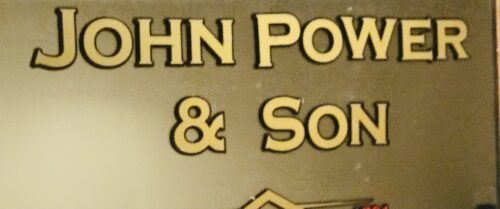
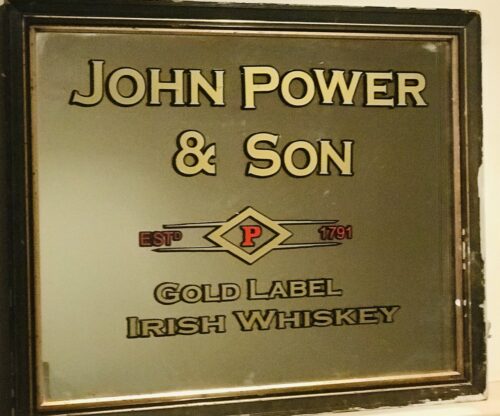 Stunning 1940's-50's Power's Pure Pot Still Whiskey Mirror.Please contact us directly at irishpubemporium@gmail.com for pricing and shipment quotation. 65cm x 80cm 8kg Dublin In 1791 James Power, an innkeeper from Dublin, established a small distillery at his public house at 109 Thomas St., Dublin. The distillery, which had an output of about 6,000 gallons in its first year of operation, initially traded as James Power and Son, but by 1822 had become John Power & Son, and had moved to a new premises at John's Lane, a side street off Thomas Street. At the time the distillery had three pot stills, though only one, a 500-gallon still is thought to have been in use. Following reform of the distilling laws in 1823, the distillery expanded rapidly. In 1827, production was reported at 160,270 gallons,and by 1833 had grown to 300,000 gallons per annum. As the distillery grew, so too did the stature of the family. In 1841, John Power, grandson of the founder was awarded a baronet, a hereditary title. In 1855, his son Sir James Power, laid the foundation stone for the O'Connell Monument, and in 1859 became High Sheriff of Dublin. In 1871, the distillery was expanded and rebuilt in the Victorian style, becoming one of the most impressive sights in Dublin.After expansion, output at the distillery rose to 700,000 gallons per annum, and by the 1880s, had reached about 900,000 gallons per annum, at which point the distillery covered over six acres of central Dublin, and had a staff of about 300 people.During this period, when the Dublin whiskey distilleries were amongst the largest in the world, the family run firms of John Powers, along with John Jameson, William Jameson, and George Roe, (collectively known as the "Big Four") came to dominate the Irish distilling landscape, introducing several innovations. In 1886, John Power & Son began bottling their own whiskey, rather than following the practice customary at the time, of selling whiskey directly to merchants and bonders who would bottle it themselves. They were the first Dublin distillery to do so, and one of the first in the world.A gold label adorned each bottle and it was from these that the whiskey got the name Powers Gold Label. When Alfred Barnard, the British historian visited John's Lane in the late 1880s, he noted the elegance and cleanliness of the buildings, and the modernity of the distillery, describing it as "about as complete a work as it is possible to find anywhere". At the time of his visit, the distillery was home to five pot stills, two of which with capacities of 25,000 gallons, were amongst the largest ever built.In addition, Barnard was high in his praise for Powers whiskey, noting:"The old make, which we drank with our luncheon was delicious and finer than anything we had hitherto tasted.It was as perfect in flavour, and as pronounced in the ancient aroma of Irish Whiskey so dear to to the hearts of connoisseurs,as one could possibly desire and we found a small flask of it very useful afterwards on our travels." The last member of the family to sit on the board was Sir Thomas Talbot Power,who died in 1930,and with him the Power's Baronetcy. However, ownership remained in the family until 1966, and several descendants of his sisters remained at work with the company until recent times. In 1961, a Coffey still was installed in John's Lane Distillery, allowing the production of vodka and gin, in addition to the testing of grain whiskey for use in blended whiskey. This was a notable departure for the firm, as for many years the big Dublin distilling dynasties had shunned the use of Coffey stills, questioning if their output, grain whiskey could even be termed whiskey. However, with many of the Irish distilleries having closed in the early 20th century in part due to their failure to embrace a change in consumer preference towards blended whiskey, Powers were instrumental in convincing the remaining Irish distilleries to reconsider their stance on blended whiskey. In 1966, with the Irish whiskey industry still struggling following Prohibition in the United States, the Anglo-Irish Trade War and the rise of competition from Scotch whiskey, John Powers & Son joined forces with the only other remaining distillers in the Irish Republic, the Cork Distilleries Company and their Dublin rivals John Jameson & Son, to form Irish Distillers. Soon after, in a bold move, Irish Distillers decided to close all of their existing distilleries, and to consolidate production at a new purpose-built facility in Midleton (the New Midleton Distillery) alongside their existing Old Midleton Distillery. The new distillery opened in 1975, and a year later, production ceased at John's Lane Distillery and began anew in Cork, with Powers Gold Label and many other Irish whiskeys reformulated from single pot stills whiskeys to blends. In 1989, Irish Distillers itself became a subsidiary of Pernod-Ricard following a friendly takeover.Since the closure of the John's Lane distillery, many of the distillery buildings were demolished. However, some of the buildings have been incorporated into the National College of Art and Design, and are now protected structures. In addition, three of the distillery's pot stills were saved and now located in the college's Red Square. Origins : Dublin City Dimensions : 100cm x 70cm 20kg (specially constructed damage proof shipping container)
Stunning 1940's-50's Power's Pure Pot Still Whiskey Mirror.Please contact us directly at irishpubemporium@gmail.com for pricing and shipment quotation. 65cm x 80cm 8kg Dublin In 1791 James Power, an innkeeper from Dublin, established a small distillery at his public house at 109 Thomas St., Dublin. The distillery, which had an output of about 6,000 gallons in its first year of operation, initially traded as James Power and Son, but by 1822 had become John Power & Son, and had moved to a new premises at John's Lane, a side street off Thomas Street. At the time the distillery had three pot stills, though only one, a 500-gallon still is thought to have been in use. Following reform of the distilling laws in 1823, the distillery expanded rapidly. In 1827, production was reported at 160,270 gallons,and by 1833 had grown to 300,000 gallons per annum. As the distillery grew, so too did the stature of the family. In 1841, John Power, grandson of the founder was awarded a baronet, a hereditary title. In 1855, his son Sir James Power, laid the foundation stone for the O'Connell Monument, and in 1859 became High Sheriff of Dublin. In 1871, the distillery was expanded and rebuilt in the Victorian style, becoming one of the most impressive sights in Dublin.After expansion, output at the distillery rose to 700,000 gallons per annum, and by the 1880s, had reached about 900,000 gallons per annum, at which point the distillery covered over six acres of central Dublin, and had a staff of about 300 people.During this period, when the Dublin whiskey distilleries were amongst the largest in the world, the family run firms of John Powers, along with John Jameson, William Jameson, and George Roe, (collectively known as the "Big Four") came to dominate the Irish distilling landscape, introducing several innovations. In 1886, John Power & Son began bottling their own whiskey, rather than following the practice customary at the time, of selling whiskey directly to merchants and bonders who would bottle it themselves. They were the first Dublin distillery to do so, and one of the first in the world.A gold label adorned each bottle and it was from these that the whiskey got the name Powers Gold Label. When Alfred Barnard, the British historian visited John's Lane in the late 1880s, he noted the elegance and cleanliness of the buildings, and the modernity of the distillery, describing it as "about as complete a work as it is possible to find anywhere". At the time of his visit, the distillery was home to five pot stills, two of which with capacities of 25,000 gallons, were amongst the largest ever built.In addition, Barnard was high in his praise for Powers whiskey, noting:"The old make, which we drank with our luncheon was delicious and finer than anything we had hitherto tasted.It was as perfect in flavour, and as pronounced in the ancient aroma of Irish Whiskey so dear to to the hearts of connoisseurs,as one could possibly desire and we found a small flask of it very useful afterwards on our travels." The last member of the family to sit on the board was Sir Thomas Talbot Power,who died in 1930,and with him the Power's Baronetcy. However, ownership remained in the family until 1966, and several descendants of his sisters remained at work with the company until recent times. In 1961, a Coffey still was installed in John's Lane Distillery, allowing the production of vodka and gin, in addition to the testing of grain whiskey for use in blended whiskey. This was a notable departure for the firm, as for many years the big Dublin distilling dynasties had shunned the use of Coffey stills, questioning if their output, grain whiskey could even be termed whiskey. However, with many of the Irish distilleries having closed in the early 20th century in part due to their failure to embrace a change in consumer preference towards blended whiskey, Powers were instrumental in convincing the remaining Irish distilleries to reconsider their stance on blended whiskey. In 1966, with the Irish whiskey industry still struggling following Prohibition in the United States, the Anglo-Irish Trade War and the rise of competition from Scotch whiskey, John Powers & Son joined forces with the only other remaining distillers in the Irish Republic, the Cork Distilleries Company and their Dublin rivals John Jameson & Son, to form Irish Distillers. Soon after, in a bold move, Irish Distillers decided to close all of their existing distilleries, and to consolidate production at a new purpose-built facility in Midleton (the New Midleton Distillery) alongside their existing Old Midleton Distillery. The new distillery opened in 1975, and a year later, production ceased at John's Lane Distillery and began anew in Cork, with Powers Gold Label and many other Irish whiskeys reformulated from single pot stills whiskeys to blends. In 1989, Irish Distillers itself became a subsidiary of Pernod-Ricard following a friendly takeover.Since the closure of the John's Lane distillery, many of the distillery buildings were demolished. However, some of the buildings have been incorporated into the National College of Art and Design, and are now protected structures. In addition, three of the distillery's pot stills were saved and now located in the college's Red Square. Origins : Dublin City Dimensions : 100cm x 70cm 20kg (specially constructed damage proof shipping container) The Still House at John's Lane Distillery, as it looked when Alfred Barnard visited in the 1800s.
The Still House at John's Lane Distillery, as it looked when Alfred Barnard visited in the 1800s.
-
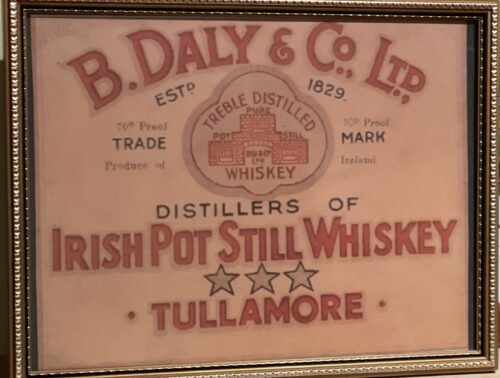
 45cm x 34cmThe Tullamore Distillery was founded in 1829 by Michael Molloy, in Tullamore, County Offaly, Ireland. When Molloy dead, in 1846, the distillery passed into the hands of one of his five nephews, Bernard Daly, and under the general management of Daniel E. Williams. 40 years later, in 1887, Bernard Daly died, and Tullamore Distillery passed to his son Captain Bernard Daly, who left, as always, the running of the distillery to Daniel E. Williams. Under Daniel E. Williams, the Tullamore Distillery expanded and prospered, lunching the whiskey which still bears his initials, Tullamore D.E.W. Williams was very resourceful and brought electricity to Tullamore in 1893. He installed telephones and motorised automobiles in the distillery. In 1903, the distillery was incorporated into a company under the name B Daly & Co. Ltd., of which both Daly and Williams had shares. The Tullamore Distillery, finally, came under complete control of Williams family in 1931. From 1925 to 1937, due to the advent of competition and to cut costs, Tullamore Distillery was temporarily mothballed. In the 1940s, Desmond, the grandson of Daniel E. Williams, began into alternative products, and with whiskey sales still languishing, the company decided to focus its resources on the liqueur Irish Mist. Therefore, distilling operations ceased in Tullamore in 1954, and production was temporarily moved to Power's Distillery in Dublin, and was later moved to Midleton Distillery and Bushmill's Distillery. William Grant & Sons acquired Tullamore brand in 2010 and, in March 2012, they announced that they were in the final stages of negotiations to acquire a site at Clonminch, situated on the outskirts of Tullamore. Construction of a new distillery began in May 2013 and in autumn 2014, the distillery was ready to start production in its ancestral home of Tullamore. The construction will be executed in three phases where the first was a pot still distillery with the possibility to distil 1,8 million litres per year. In early 2016, it was increased to 3,6 million litres by the addition of more stills and washbacks. Finally, a grain distillery and bottling plant were added in 2017. Tullamore can now produce all three components of its Tullamore D.E.W. blended whiskey on-site.
45cm x 34cmThe Tullamore Distillery was founded in 1829 by Michael Molloy, in Tullamore, County Offaly, Ireland. When Molloy dead, in 1846, the distillery passed into the hands of one of his five nephews, Bernard Daly, and under the general management of Daniel E. Williams. 40 years later, in 1887, Bernard Daly died, and Tullamore Distillery passed to his son Captain Bernard Daly, who left, as always, the running of the distillery to Daniel E. Williams. Under Daniel E. Williams, the Tullamore Distillery expanded and prospered, lunching the whiskey which still bears his initials, Tullamore D.E.W. Williams was very resourceful and brought electricity to Tullamore in 1893. He installed telephones and motorised automobiles in the distillery. In 1903, the distillery was incorporated into a company under the name B Daly & Co. Ltd., of which both Daly and Williams had shares. The Tullamore Distillery, finally, came under complete control of Williams family in 1931. From 1925 to 1937, due to the advent of competition and to cut costs, Tullamore Distillery was temporarily mothballed. In the 1940s, Desmond, the grandson of Daniel E. Williams, began into alternative products, and with whiskey sales still languishing, the company decided to focus its resources on the liqueur Irish Mist. Therefore, distilling operations ceased in Tullamore in 1954, and production was temporarily moved to Power's Distillery in Dublin, and was later moved to Midleton Distillery and Bushmill's Distillery. William Grant & Sons acquired Tullamore brand in 2010 and, in March 2012, they announced that they were in the final stages of negotiations to acquire a site at Clonminch, situated on the outskirts of Tullamore. Construction of a new distillery began in May 2013 and in autumn 2014, the distillery was ready to start production in its ancestral home of Tullamore. The construction will be executed in three phases where the first was a pot still distillery with the possibility to distil 1,8 million litres per year. In early 2016, it was increased to 3,6 million litres by the addition of more stills and washbacks. Finally, a grain distillery and bottling plant were added in 2017. Tullamore can now produce all three components of its Tullamore D.E.W. blended whiskey on-site.- 1829 Tullamore Distillery was founded by Michael Molloy, in Tullamore, County Offaly, Ireland
- 1846 Molloy dead and the distillery passed into the hands of one of his five nephews, Bernard Daly
- 1887 Bernard Daly dead and Tullamore Distillery passed to his son Captain B. Daly
- 1893 Williams brought electricity to Tullamore
- 1903 The distillery was incorporate under tha name B Daly & Co. Ltd.
- 1925-1937 Tullamore Distillery was temporarily closed
- 1931 Tullamore came under complete control of Williams family
- 1954 The old Tullamore Distillery closed and production was transferred to the Midleton Distillery
- 2010 The brand was purchased by William Grant & Sons, who invested €35 million in the construction of the new Tullamore Distillery
- 2014 The new Tullamore Distillery opened
-

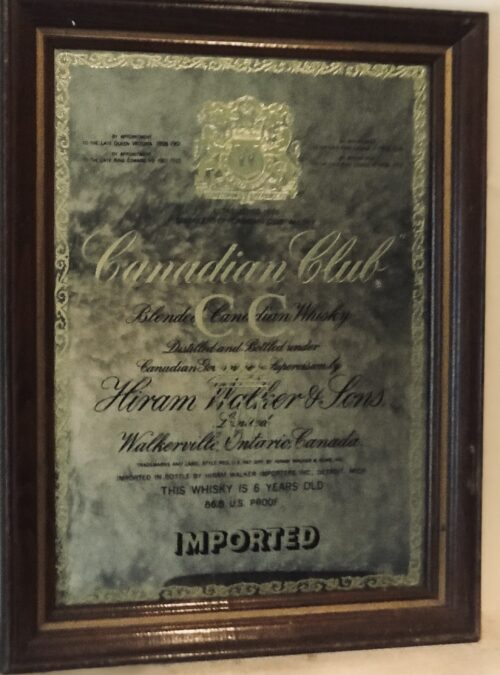 A very gracious and substantial Canadian Club Whiskey Mirror.Ok it might have originated from Windsor,Ontario when Hiram Walker moved his distillery across the Detroit River due to prohibition but we recovered this gem from a once famous public house in Killarney Co Kerry.The owner had returned from Canada to open his own pub in his native town and the first item he adorned his new pub was with this lovely mirror. Killarney Co Kerry (via Ontario) 53cm x 40cm
A very gracious and substantial Canadian Club Whiskey Mirror.Ok it might have originated from Windsor,Ontario when Hiram Walker moved his distillery across the Detroit River due to prohibition but we recovered this gem from a once famous public house in Killarney Co Kerry.The owner had returned from Canada to open his own pub in his native town and the first item he adorned his new pub was with this lovely mirror. Killarney Co Kerry (via Ontario) 53cm x 40cm -
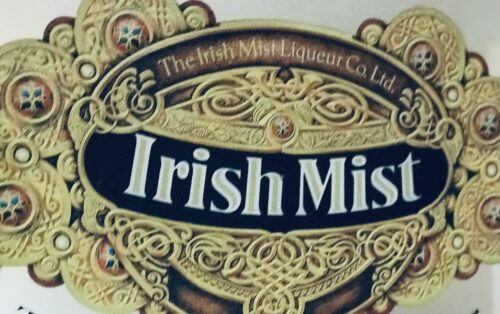
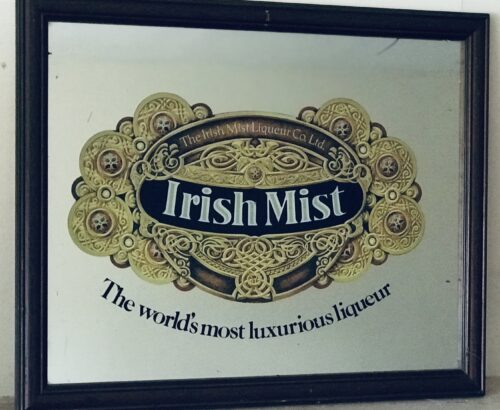 Lovely Irish Mist Pub Mirror-the Worlds Most Luxurious Liqueur Pub Mirror . Edenderry Co Offaly. 60cm x 50cm Irish Mist is a brown Whiskey Liqueur produced in Dublin, Ireland, by the Irish Mist Liqueur Company Ltd. In September 2010 it was announced that the brand was being bought by Gruppo Campari from William Grant, only a few months after Grants had bought it from the C&C Group. It is made from aged Irish whiskey, heather and clover honey, aromatic herbs, and other spirits, blended to an ancient recipe claimed to be 1,000 years old.Though it was once 80 US proof (40% alcohol per volume), Irish Mist is now 35% or 70 US proof. The bottle shape has also been changed from a “decanter” style to a more traditional whiskey bottle shape. It is currently available in more than 40 countries. Irish Mist was the first liqueur to be produced in Ireland when commercial production began in 1947 at Tullamore, County Offaly. Tullamore is the hometown of the Williams family who were the original owners of Irish Mist. The company history goes back to 1829 when the Tullamore Distillery was founded to produce Irish whiskey. In the mid-1940s Desmond E. Williams began the search for an alternative yet related product, eventually deciding to produce a liqueur based on the ancient beverage known as heather wine.In 1985 the Cantrell & Cochrane Group purchased the Irish Mist Liqueur Company from the Williams family. In the summer of 2010 Irish Mist and the entire spirit division of C&C was bought by William Grant of Scotland. In September 2010 they in turn sold Irish Mist to Gruppo Campari.Irish Mist is typically served straight up or on ice, but also goes with coffee, vodka, or cranberry juice. Per the makers, Irish Mist’s most popular recipe is Irish Mist with Cola and Lime. A Rusty Mist is an ounce of Irish Mist with an ounce of Drambuie Scotch whisky liqueur.A Black Nail is made from equal parts Irish Mist and Irish whiskey.
Lovely Irish Mist Pub Mirror-the Worlds Most Luxurious Liqueur Pub Mirror . Edenderry Co Offaly. 60cm x 50cm Irish Mist is a brown Whiskey Liqueur produced in Dublin, Ireland, by the Irish Mist Liqueur Company Ltd. In September 2010 it was announced that the brand was being bought by Gruppo Campari from William Grant, only a few months after Grants had bought it from the C&C Group. It is made from aged Irish whiskey, heather and clover honey, aromatic herbs, and other spirits, blended to an ancient recipe claimed to be 1,000 years old.Though it was once 80 US proof (40% alcohol per volume), Irish Mist is now 35% or 70 US proof. The bottle shape has also been changed from a “decanter” style to a more traditional whiskey bottle shape. It is currently available in more than 40 countries. Irish Mist was the first liqueur to be produced in Ireland when commercial production began in 1947 at Tullamore, County Offaly. Tullamore is the hometown of the Williams family who were the original owners of Irish Mist. The company history goes back to 1829 when the Tullamore Distillery was founded to produce Irish whiskey. In the mid-1940s Desmond E. Williams began the search for an alternative yet related product, eventually deciding to produce a liqueur based on the ancient beverage known as heather wine.In 1985 the Cantrell & Cochrane Group purchased the Irish Mist Liqueur Company from the Williams family. In the summer of 2010 Irish Mist and the entire spirit division of C&C was bought by William Grant of Scotland. In September 2010 they in turn sold Irish Mist to Gruppo Campari.Irish Mist is typically served straight up or on ice, but also goes with coffee, vodka, or cranberry juice. Per the makers, Irish Mist’s most popular recipe is Irish Mist with Cola and Lime. A Rusty Mist is an ounce of Irish Mist with an ounce of Drambuie Scotch whisky liqueur.A Black Nail is made from equal parts Irish Mist and Irish whiskey. -
 Beautifully atmospheric Raymond Campbell still life print depicting a familiar scene of an Irish Bar shelf or kitchen dresser.You can almost reach out and touch the bottles of Powers & Jameson Whiskey plus assorted items such as an old hurling sliotar,a sea shell, postcards etc Origins :Bray Co Wicklow. Dimensions : 68cm x 55cm. Unglazed Raymond Campbell has long been known as one of the modern masters of still life oil paintings. Instantly recognisable, his artwork is often characterised by arrangements of dusty vintage wine bottles, glasses and selections of fruit and cheeses. What isn’t so known about Raymond is how he began his working life as a refuse collector and laying carpets. Indeed it was the former which allowed him to salvage many of the vintage bottles which he uses for his subject matter to this day. Born in 1956 in Surrey, Raymond Campbell is now considered by many as the United Kingdom’s pre-eminent still life artist. His works “Second Home”, “The Gamble” and “The Lost Shoe” are among pieces which have been exhibited at The Summer Exhibition at The Royal Academy, London. He has had many sell-out one man exhibitions and has also exhibited several times at The Mall Galleries, London and numerous other galleries worldwide. His work can be found in many international private collections, particularly in the USA, Australia and across Europe.
Beautifully atmospheric Raymond Campbell still life print depicting a familiar scene of an Irish Bar shelf or kitchen dresser.You can almost reach out and touch the bottles of Powers & Jameson Whiskey plus assorted items such as an old hurling sliotar,a sea shell, postcards etc Origins :Bray Co Wicklow. Dimensions : 68cm x 55cm. Unglazed Raymond Campbell has long been known as one of the modern masters of still life oil paintings. Instantly recognisable, his artwork is often characterised by arrangements of dusty vintage wine bottles, glasses and selections of fruit and cheeses. What isn’t so known about Raymond is how he began his working life as a refuse collector and laying carpets. Indeed it was the former which allowed him to salvage many of the vintage bottles which he uses for his subject matter to this day. Born in 1956 in Surrey, Raymond Campbell is now considered by many as the United Kingdom’s pre-eminent still life artist. His works “Second Home”, “The Gamble” and “The Lost Shoe” are among pieces which have been exhibited at The Summer Exhibition at The Royal Academy, London. He has had many sell-out one man exhibitions and has also exhibited several times at The Mall Galleries, London and numerous other galleries worldwide. His work can be found in many international private collections, particularly in the USA, Australia and across Europe. -
Out of stock
 Ferns Co Wexford. 30cm x 26cm Bishop's Water Distillery was an Irish whiskey distillery which operated in Wexford, Ireland between 1827 and 1914. The distillery was named for a stream which ran along the back of the distillery, the Bishop's Water, said to possess "various occult properties derived from the blessings of the sainted Bishop of Ferns". Constructed at a cost of £30,000, the distillery was reported to be “reckoned the most perfect and complete of the kind in Ireland”. In 1833, just a few years after it opened, the distillery recorded an output of about 200,000 gallons per annum .However, output had fallen to just 110,000 gallons per annum in 1886, when the distillery was visited by Alfred Barnard, as recorded in his seminal 1887 publication "The Whisky Distilleries of the United Kingdom". This was amongst the lowest output of any distillery operating in Ireland at the time, and far below the potential output of 250,000 gallons per annum reported when the distillery was offered for sale as a going concern in 1909.The distillery's whiskey, Barnard noted, was highly appreciated locally, and in the British cities where it was exported. In the early 20th century, with the Irish whiskey industry in decline, Bishop's Water distillery, like the majority of distilleries in Ireland at the time, suffered serious financial difficulties, and entered bankruptcy. Following its closure, the distillery was initially converted into an iron works (Pierce Ironworks). However, much of the site was later demolished, and little evidence of the distillery still remains. Some mementos can still be found in locals pubs, while a stone archway known to have been extant in 1903 and now bearing the inscription "Casa Rio", possibly in reference to the location of a Pierce ironworks office in Buenos Aires, marks the entrance to the site where the distillery once stood, on Distillery Road.
Ferns Co Wexford. 30cm x 26cm Bishop's Water Distillery was an Irish whiskey distillery which operated in Wexford, Ireland between 1827 and 1914. The distillery was named for a stream which ran along the back of the distillery, the Bishop's Water, said to possess "various occult properties derived from the blessings of the sainted Bishop of Ferns". Constructed at a cost of £30,000, the distillery was reported to be “reckoned the most perfect and complete of the kind in Ireland”. In 1833, just a few years after it opened, the distillery recorded an output of about 200,000 gallons per annum .However, output had fallen to just 110,000 gallons per annum in 1886, when the distillery was visited by Alfred Barnard, as recorded in his seminal 1887 publication "The Whisky Distilleries of the United Kingdom". This was amongst the lowest output of any distillery operating in Ireland at the time, and far below the potential output of 250,000 gallons per annum reported when the distillery was offered for sale as a going concern in 1909.The distillery's whiskey, Barnard noted, was highly appreciated locally, and in the British cities where it was exported. In the early 20th century, with the Irish whiskey industry in decline, Bishop's Water distillery, like the majority of distilleries in Ireland at the time, suffered serious financial difficulties, and entered bankruptcy. Following its closure, the distillery was initially converted into an iron works (Pierce Ironworks). However, much of the site was later demolished, and little evidence of the distillery still remains. Some mementos can still be found in locals pubs, while a stone archway known to have been extant in 1903 and now bearing the inscription "Casa Rio", possibly in reference to the location of a Pierce ironworks office in Buenos Aires, marks the entrance to the site where the distillery once stood, on Distillery Road.History
In 1827, a whiskey distillery was established on what is now Distillery Road, Wexford by a consortium of businessmen. The consortium which traded under "Devereux, Harvey, and Co., Distillers", comprised a number of local businessmen, including Nicholas Devereux, his father John Devereux, and Maurice Crosbie Harvey. John Devereux had previously operated a small distillery in the area in the late 1700s, but will little success.In 1830, one of the partners, Maurice Harvey, was accidentally killed at the distillery by an excise man who was taking aim at some birds flying overhead.A few years later, in 1836, the partnership was dissolved at the mutual consent of the remaining partners, with Nicholas Devereux taking sole ownership of the distillery, after which the distillery traded under the name Nicholas Devereux & Son.On his death in 1840, operation of the distillery was taken over by his son Richard. Nichloas Devereux's daughter, Mary Anne Therese was also deeply involving in the distilling industry. She married John Locke, founder of the larger Kilbeggan distillery, and successfully took over the business operations of the distillery on his death in 1868. According to Alfred Barnard, the British journalist who visited Bishop's Water in the 1880s, the distillery produced triple-distilled "old pot still whiskey", which was sold locally in Ireland, and also exported to London, Liverpool, and Bristol. At the time of his visit, the Malt Warehouses on-site contained over 16,000 barrels of pure malt. In addition, upwards of 3,000 casks of whiskey were undergoing maturation at the distillery. Whiskey from the distillery is also noted to have been used in the production of blended whiskeys in later years. In the early 20th century, the distillery suffered financial difficulties. In 1907, an attempt was made to appoint a receiver, and in 1909, the distillery was put up for sale, but no takers could be found.In 1914, distilling eventually ceased at the site, and the remaining stocks were sold off.


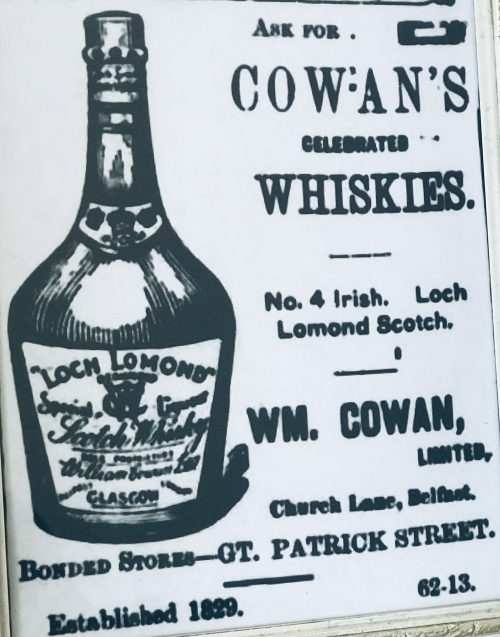
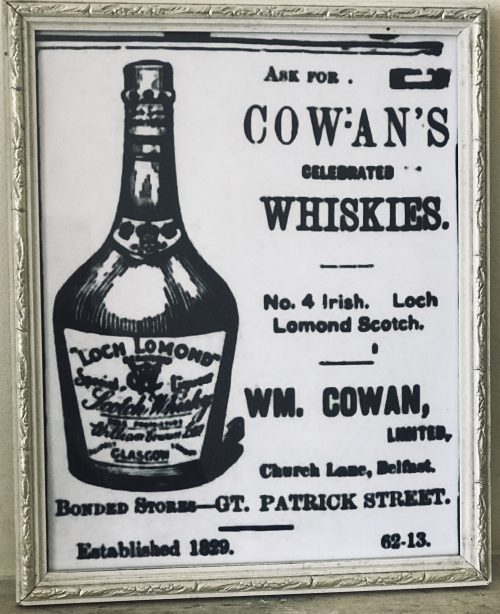





 antr
antr
